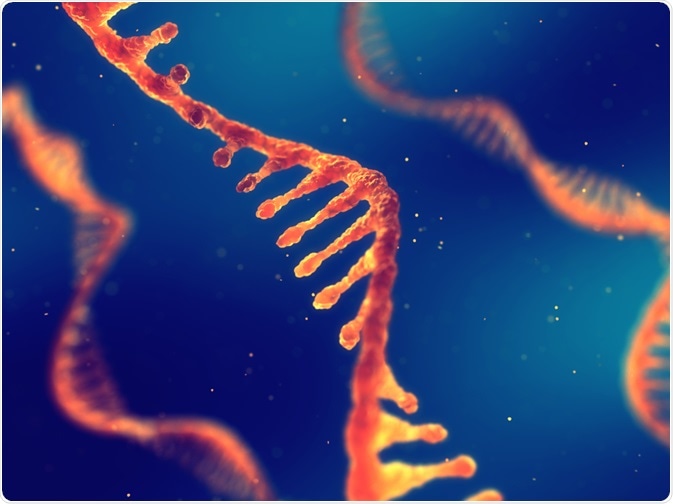DNA translation is the term used to describe the process of protein synthesis by ribosomes in the cytoplasm or endoplasmic reticulum.
 Image Credit: nobeastsofierce / Shutterstock
Image Credit: nobeastsofierce / Shutterstock
The genetic information in DNA is used as a basis to create messenger RNA (mRNA) by transcription. Single stranded mRNA then acts as a template during translation.
Ribosomes facilitate translation in the cytoplasm, by inducing the binding of complimentary transfer RNA (tRNA) anticodon sequences to the mRNA.
tRNAs carry particular amino acids, which are linked together by the ribosome. In this process, the mRNA is decoded to produce a specific amino acid chain, known as a polypeptide. Folding of the polypeptide creates an active protein, able to perform functions within the cell.
Cellular components involved in DNA translation
The key components required for translation are mRNA, tRNA, ribosomes, and aminoacyl tRNA synthetases. These four structures are briefly explained below:
Ribosome
The ribosome is a complex organelle, present in the cytoplasm, which serves as the site of action for protein synthesis. It provides the enzymes needed for peptide bond formation.
The nucleotide sequence in mRNA is recognized in triplets, called codons. The ribosome moves along the single strand mRNA, and when a complimentary codon sequence belonging to amino acid bearing tRNA bonds with the mRNA, the amino acid is added to the chain.
The mRNA possesses a stop codon, a sequence of three nucleotides that indicates that translation is complete. Upon reaching the stop codon, the ribosome ceases translation and releases the mRNA and newly generated polypeptide.
Messenger RNA (mRNA)
mRNA is used to convey information from DNA to the ribosome. It is a single strand molecule, complimentary to the DNA template, and is generated through transcription. Strands of mRNA are made up of codons, each of which signifies a particular amino acid to be added to the polypeptide in a certain order.
mRNA must interact with ribosomal RNA (rRNA), the central component of ribosomal machinery that recognizes the start and stop codons of mRNA, and tRNA, which provides the amino acid once bound with a complimentary mRNA codon.
Transfer RNA (tRNA)
This is a single strand of RNA composed of approximately 80 ribonucleotides. Each tRNA is read as a ribonucleotide triplet called an anticodon that is complementary to an mRNA codon. tRNA carry a particular amino acid, which is added to the growing polypeptide chain if complimentary codons bond.
Aminoacyl tRNA synthetases
These are enzymes that link each amino acid to their corresponding tRNA with the help of a two-step process. Each amino acid has a unique synthetase and the active site of each enzyme fits only one specific combination of the amino acid and tRNA.
Steps involved in DNA translation
There are three major steps in translation: initiation, elongation, and termination. These steps are briefly discussed below:
Initiation
Small ribosomal subunits bind to mRNA. The initiator tRNA which is equipped with the anticodon (UAC) also binds to the start codon (AUG) of the mRNA. The resulting large complex forms a complete ribosome and initiates protein synthesis.
Elongation
Following initiation, a new tRNA-amino acid complex enters the codon next to the AUG codon. If the anticodon of the new tRNA matches the mRNA codon, base pairing occurs and the two amino acids are linked by the ribosome through a peptide bond.
If the anticodon does not match the codon, base pairing cannot happen and the tRNA is rejected. Then, the ribosome moves one codon forward making space for a new tRNA-amino acid complex to enter. This process is repeated several times until the entire polypeptide has been translated.
Termination
As the ribosome moves along the mRNA, it encounters one of the three stop codons for which there is no corresponding tRNA. Terminator proteins present at the stop codon bind to the ribosome and trigger the release of the newly synthesized polypeptide chain.
The ribosome then disengages from the mRNA. On release from the mRNA, the small and large subunits of the ribosome dissociate and prepare for the next round of translation.
The polypeptide chains produced during translation undergo some post-translational modifications, such as folding, before becoming a fully active protein.
Translation
Further Reading
Last Updated: Apr 30, 2019